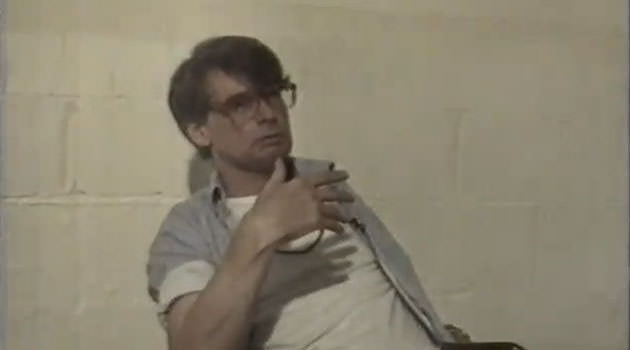He was suddenly conscious of the fact that it was morning and soon his now asleep bedmate would leave. He reached out to his body and the touch of his warm body aroused him. He did not want him to leave. He looked around and spotted the fellow’s tie among the clothes they had shed the last night. Recalling the incident four years later he wrote, “I raised myself and slipped it on under his neck. I quickly straddled him and pulled tight for all I was worth. His body came alive immediately. We struggled off the bed onto the floor.” But he did not let go until his victim stopped struggling. He was not dead yet, but was simply unconscious.
Then he brought a bucket of water from the kitchen and lifted the man up onto a few chairs and sunk the man’s head into the water. Unconscious, the man did not struggle much and soon the bubbles from his mouth and nostrils stopped. He was dead. And the killer had no idea what the name of his victim was. All he remembered was that he had met the man in a pub and had invited him home at 195 Melrose Avenue in London. This was late 1978.
Finally, the man was there to stay, at least physically. He didn’t know what to do next. After a cup of coffee and several cigarettes he removed the tie from his neck, looked at him for a while and then took his lifeless friend to the bathroom to give him a wash. He dried him and brought him back to the room and put him in bed with the bedcover pulled over. The body looked rather beautiful to him. And it was not going anywhere. Ever.
Later in the day he bought an electric knife and a pot but could not bring himself to actually cut the body. So, he dressed the body in new underwear instead after which he went for a bath. He also tried having sex with the body but could not sustain the initial arousal. He pulled the body off the bed onto the floor. And then went to sleep in the same bed with the body still lying on the floor. After the sleep, he made dinner, watched television for a while. The body kept lying right there on the floor all the while.
 Something had to be done about the body because it could not simply lie there for ever. So, he pried open some of the floorboards and tried to tuck the body into the space. The rigor mortis made the task impossible. He decided to stand the body against the wall and wait until the body was a bit less stiff. But nothing much happened and the body was still standing almost as stiff the next. So, he laid it on the floor again and worked on the limbs to soften them. Finally, he was able to put the body under the floorboards with the carpet pulled over.
Something had to be done about the body because it could not simply lie there for ever. So, he pried open some of the floorboards and tried to tuck the body into the space. The rigor mortis made the task impossible. He decided to stand the body against the wall and wait until the body was a bit less stiff. But nothing much happened and the body was still standing almost as stiff the next. So, he laid it on the floor again and worked on the limbs to soften them. Finally, he was able to put the body under the floorboards with the carpet pulled over.
A week passed. And now he was curious about the body. So, he rolled the carpet over and removed the floorboards. The dirty corpse needed a wash. After washing the body he bathed in the same water. By the time he got the body to the room he was aroused and masturbated on the stomach of the corpse.
The corpse stayed with him for a while before going under the floorboards again for another seven months and a half, after which he burnt the remains in a bonfire with rubber thrown into the fire to subdue the unmistakable stench of burning flesh. The ashes were buried under the ground. The dead man was never identified. It was difficult for the killer to believe that he could get away with it so easily, but at that time he did believe that it wouldn’t happen again. But it did happen again; at least fourteen times. And little did he know that he, Denis Andrew Nilsen, was going to be remembered as one of the most cold hearted serial killers in the history of mankind.
The second victim was a Canadian tourist, Kenneth Ockendon, who met Nilsen at lunch time at a pub on December 3, 1979. After drinking for hours and taking a tour of London, they winded up in his flat. Both got along well and he was increasingly getting uncomfortable at the thought that Ockendon was to leave for home the next day. He wanted to keep him. Ockendon was strangled with wires from headphones, dragged him down to the floor and put some music on. After listening to music for a while he took the body to the bathroom and gave it a wash. He brought his companion back to the bed and slept alongside in the same bed for the rest of the night. He kept caressing the body every now and then throughout the night.
The next morning he closeted the body in the cupboard and went to work. A day later, he took the body out and cleaned it again, after which he dressed it and sat him in a chair clicking several pictures of it. After that he took it to bed, crossed his legs and masturbated between his thighs. Ockendon was then put under the floorboards. However, the dead victim was brought out several times, as his killer wanted to watch television with him.
On May 13, 1980, Martyn Duffey (16), who was homeless accepted the invitation to spend a night with a newfound friend never to return. He was strangled and drowned in the bucket, after which the killer bathed with the killed and the victim remained in the cupboard for two weeks before going under the floorboard.
Billy Sutherland (27) was a male prostitute who slept with men for money. He was not really invited but followed him to his place after they went bar-hopping. Malcolm Barlow (24) had mental problems and was found near his house complaining of weakness from epilepsy. He called an ambulance, but after he was released he came straight back to wait at his doorsteps until he returned. He invited Barlow in. And Barlow went into the cabinet under the sink. Nilsen was now living amidst half a dozen bodies in different stages of decay – stacked away in cabinets, cupboards and under floorboards – awaiting disposal. A few of these bodies had shared bed with Nilsen for nearly a week. Nilsen derived a thrill from having control over all these men.
Twice a day Nilsen sprayed his house to get rid of the flies. But then, the bodies had to be taken care of and to do that he would let his dog, Bleep, out, and also his cat, strip to his underwear and start cutting the bodies up on the kitchen floor with a kitchen knife. He had once been a butcher in the army, and the expertise came in handy. He buried pieces of the body in his garden and stuffed some of the torsos in the suitcases and when he found an opportune moment, he would take the suitcases out and burn the torsos in a bonfire near the garden fence. The remains of six men went under the ground after that. Five more men died in the apartment and their remains went ablaze in the third bonfire before Nilsen shifted to another place. After his arrest when the police found over 1000 bone fragments in the garden.
 Nilsen’s new place did not give him the advantage of a garden and there could not be any bonfires. Besides, there were not floorboards. Nilsen’s new flat at 23 Cranley Gardens was actually an attic. So, he felt that this could be an effective deterrent against his compulsive homicidal tendencies. He was wrong.
Nilsen’s new place did not give him the advantage of a garden and there could not be any bonfires. Besides, there were not floorboards. Nilsen’s new flat at 23 Cranley Gardens was actually an attic. So, he felt that this could be an effective deterrent against his compulsive homicidal tendencies. He was wrong.
Nilsen was in a pub drinking alone when he got friendly with a guy called John Howlett, who came home with him. After a few drinks Nilsen wanted the guy to leave, but he stayed. And could never leave. He too was strangled. Disposal was a problem and Nilsen was in hurry because he had a friend coming over. So, he decided to chop the body into small pieces and shove it down the lavatory. When that took longer than expected, he boiled some of the flesh in a pan together with hands, feet and head. He separated the bones and trashed them while some of the larger ones were simply flung across into a waste area. Some parts were stuffed in a bag with salt sprinkled over and placed in a tea chest, which was shrouded in a red curtain.
Two more men were to share the same fate before Nilsen was arrested. The sewer choked and the company that came in to clean it found that at the bottom of the sewer there was an eight inches thick sludge of thirty or forty flesh pieces. Nilsen was among the neigbours who actually saw the pile of rotting flesh. Nilsen did not try to run away. He just stayed and worked like always, and was arrested. He confessed and was very forthcoming with the details of his crime.
“The victim is the dirty platter after the feast and the washing up is an ordinary clinical task,” Nilsen told the police.
The trial began on October 24, 1983, Nilsen pleaded ‘Not Guilty’ to all charges, was convicted on November 4, 1983 and was sentenced to life in prison with no parole for 25 years. He was nearly 38 by that time, born on November 23, 1945 (now 63).
Originally written for and published in LAWYERS UPDATE as CRIME FILE in August 2009.





